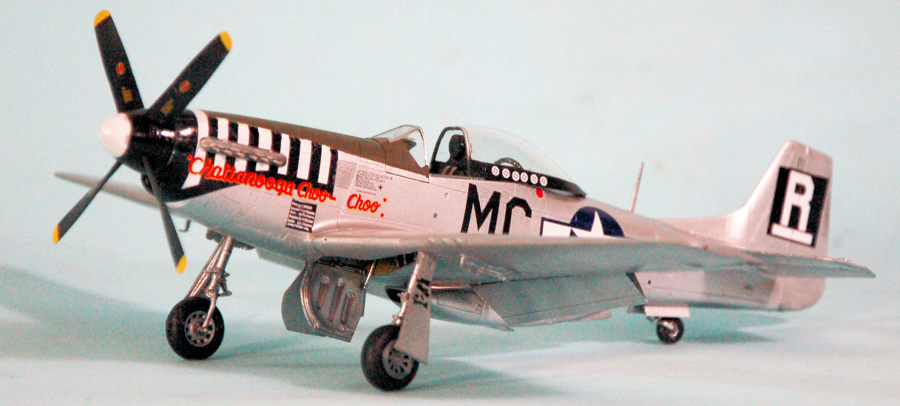
Eduard 1/48 P-51D Mustang
| KIT #: | 04249 |
| PRICE: | $54.95 SRP |
| DECALS: | Six options |
| REVIEWER: | Tom Cleaver |
| NOTES: | 2019 tooling |

| HISTORY |
As it turns out, there is more to the P-51D than many modelers have previously thought. There are minor but important differences between each sub-type, from whether they have a dorsal fin or not, to whether or not they have fabric-covered or metal elevators (which changes the angle of incidence of the horizontal stabilizer), and several other small details. All of these differences have been noted by Eduard and are up on their website in detail with drawings to show what they’re talking about. And it appears that Eduard is pretty well committed to producing kits of the P-51D that will take note of those changes. This kit is not a “generic” P-51D as most others before have been.
| THE KIT |
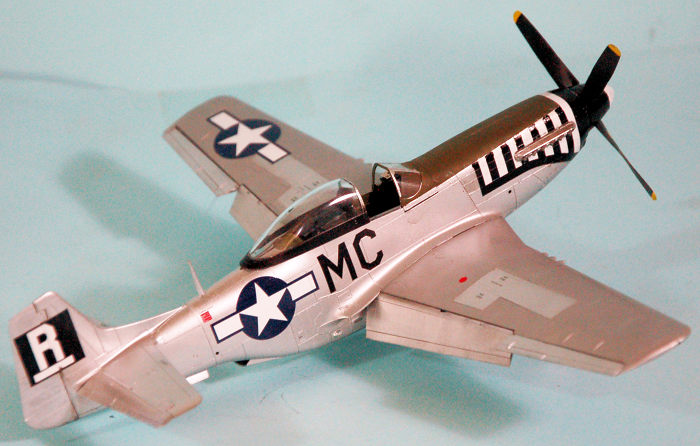 P-51Ds have
been around for about as long as there have been plastic scale model kits. In
1/48, the first to approach accuracy was the old Hawk (now Testors) P-51D
released in the early 60s. This was as good as it got until the 1970s, when
Otaki and Revell released kits; the earlier Hawk/Testors kit was actually more
accurate in overall shape than either of these releases. The first P-51D kit to
be really accurate regarding shape was the still-available Hasegawa 1/72 kit,
released in the mid-70s, though nowadays it needs a resin cockpit and a
vacuformed canopy to really be competitive with releases in that scale like the
recent Airfix kit, considered by many to be the best P-51D in 1/72. Hasegawa
took another bite of the apple in 1992 with a P-51D in 1/48 that immediately
replaced the previous kits regarding accuracy and detail. Tamiya came along in
1994 with what became the “gold standard” for P-51Ds in 1/48, and topped that in
2012 with a 1/32 kit that is universally recognized as the best P-51D in any
scale. None of the other 1/32 kits, such as the earlier Revell kit or the
still-horrid Dragon release, one of the worst kits ever released by any company,
or the Hasegawa kit from the late 70s or the Trumpeter kit from around 10 years
ago can really be considered competitive with that kit. In 1/24, the only kit
out there is from Airfix, released some 40 years ago, which is at least outline
accurate.
P-51Ds have
been around for about as long as there have been plastic scale model kits. In
1/48, the first to approach accuracy was the old Hawk (now Testors) P-51D
released in the early 60s. This was as good as it got until the 1970s, when
Otaki and Revell released kits; the earlier Hawk/Testors kit was actually more
accurate in overall shape than either of these releases. The first P-51D kit to
be really accurate regarding shape was the still-available Hasegawa 1/72 kit,
released in the mid-70s, though nowadays it needs a resin cockpit and a
vacuformed canopy to really be competitive with releases in that scale like the
recent Airfix kit, considered by many to be the best P-51D in 1/72. Hasegawa
took another bite of the apple in 1992 with a P-51D in 1/48 that immediately
replaced the previous kits regarding accuracy and detail. Tamiya came along in
1994 with what became the “gold standard” for P-51Ds in 1/48, and topped that in
2012 with a 1/32 kit that is universally recognized as the best P-51D in any
scale. None of the other 1/32 kits, such as the earlier Revell kit or the
still-horrid Dragon release, one of the worst kits ever released by any company,
or the Hasegawa kit from the late 70s or the Trumpeter kit from around 10 years
ago can really be considered competitive with that kit. In 1/24, the only kit
out there is from Airfix, released some 40 years ago, which is at least outline
accurate.
Moving on, Airfix released a 1/48 P-51D in 2018 that raised the bar considerably from the Tamiya kit. It was the first in any of the smaller scales to have the wheel well reproduced accurately, and provided the earlier field-applied dorsal fin of the P-51D-5 and the later factory fin that showed up with the P-51D-10. It’s relatively easy to build and makes up into an attractive model.
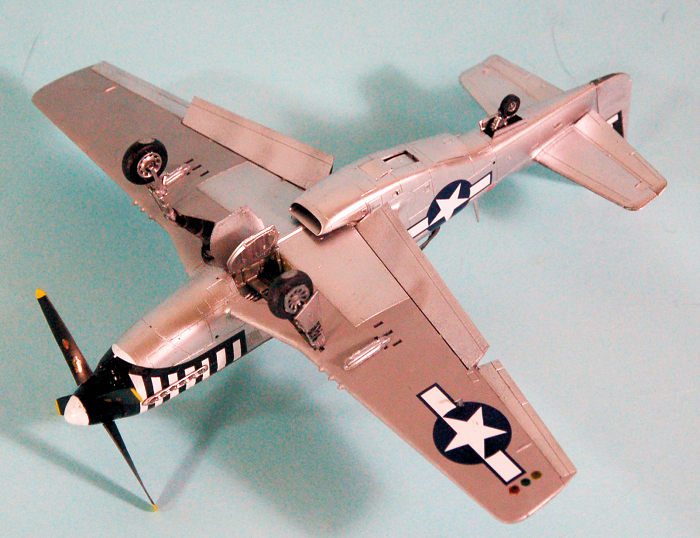 Eduard
announced two years ago that they were going to do a P-51D that would rank up
with their new-release Bf-109s, Fw-190s and Spitfire kits. Based on their recent
record, anticipation has been high about the kit, which has finally been
released this month in a Special Edition collector’s item timed to coincide with
the 2019 IPMS-USA convention held in Chattanooga TN. They have announced an
early P-51D-5NA without the dorsal fin will be released in October, and a Royal
Class kit in December that will have later versions. 2020 will undoubtedly see
more releases by Eduard.
Eduard
announced two years ago that they were going to do a P-51D that would rank up
with their new-release Bf-109s, Fw-190s and Spitfire kits. Based on their recent
record, anticipation has been high about the kit, which has finally been
released this month in a Special Edition collector’s item timed to coincide with
the 2019 IPMS-USA convention held in Chattanooga TN. They have announced an
early P-51D-5NA without the dorsal fin will be released in October, and a Royal
Class kit in December that will have later versions. 2020 will undoubtedly see
more releases by Eduard.
So, what’s there?
Opening the box and examining the parts, one can see that Eduard has definitely raised the bar very high for P-51Ds in 1/48 scale. The surface detail is stunning, even more petite than what was done in the recent Tempest V release. Many modelers have complained about the addition of rivets, since the P-51D is well-known for being flush-riveted throughout. I can only say as someone who has been around Mustangs since 1972 that this surface detail is not excessive - with the sun at the right angle on a Mustang, it is possible from a distance of 6-8 feet to see the rivets, as they are on this model. It turns out that, once the model has a coat of paint on it, the rivets in the surface detail are only visible from about a foot away, and under good light.
Past that, the kit exudes quality in the molding of the parts. The wheel well alone has 13 parts, giving the best detail of this feature in any kit outside the 1/32 Tamiya release. Three different canopies are included: the early North American - Los Angeles “teardrop” canopy, the later NA-Los Angeles release that provided more headroom for the pilot, and the “Dallas canopy.” Three propellers are included: the Hamilton-Standard cuffed and uncuffed props, and the Aeroproducts prop associated with the P-51K. There are two slightly-different-shaped spinners, one for the Hamilton-Standard and one for the Aeroproducts.
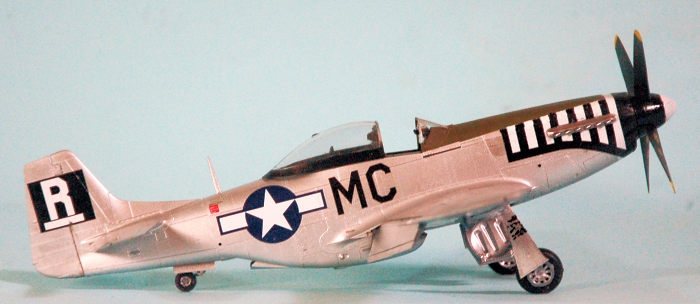 A separate
sprue includes both the 75-gallon metal drop tanks and the 108-gallon paper tank
used in the ETO are supplied. I was surprised that the metal 110-gallon tank
used in the MTO and Pacific wasn’t included. 250-pound and 500-pound bombs as
well as ten 5-inch HVARs on zero-length launchers.
A separate
sprue includes both the 75-gallon metal drop tanks and the 108-gallon paper tank
used in the ETO are supplied. I was surprised that the metal 110-gallon tank
used in the MTO and Pacific wasn’t included. 250-pound and 500-pound bombs as
well as ten 5-inch HVARs on zero-length launchers.
In the cockpit, there are parts for the early and late main instrument panel, and the three different side panels associated with the three major production changes in the cockpit. The early and late seats are also there. The photo-etch panel provided is strictly for the airplane up through to the D-15. Both the fabric-covered and later metal-covered elevators are provided. All control surfaces are separately molded, allowing a modeler to pose their model dynamically.
All in all, it’s possible with what’s in the kit to make every version of the P-51D from the D-5 with fillet through the D-30, for the modeler who knows what’s what regarding details. If you don’t know what’s what, Eduard has all the information needed on their website. In terms of quality of production, I have to score this as the P-51D kit this Mustang fanatic has been looking for, for as long as I have been building plastic models.
| CONSTRUCTION |
As with all the recent Eduard releases, this kit demands you bring as much modeling excellence to the project as it does. All parts fit very precisely, and any sloppiness in cleaning up all sprue nubs, or hamfistedness in assembly, will lead to multiple problems down the line. Take care in preparation of parts, take care in assembly, commit to the revolutionary act of following the instructions, and the result will be one of the best models you have ever created. If you do it right, you won’t be using any filler anywhere (other than on the wings if you so choose).
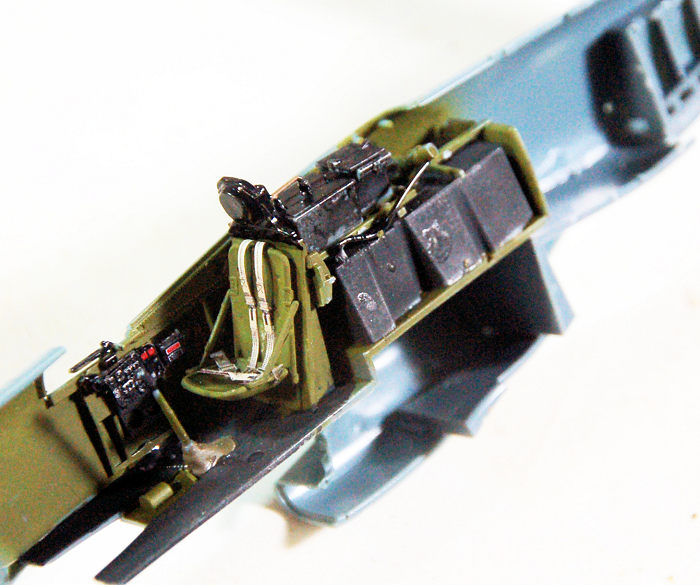 Construction begins with the cockpit. I painted all the parts on the sprue
before further assembly, following the kit instructions regarding colors. There
are a myriad of small parts, so take care in separating them from the sprue lest
you feed the carpet monster or they fly off into the Department of Lost.
Fortunately, my new government-supplied eyeballs (with 20/20 vision restored)
allowed me to put the optivisor aside, but if you have one (and haven’t had the
lens-correction operation) you’re probably going to need it to get everything
done. The result is a very good looking cockpit. I don’t think the resin guys
are going to beat this. I used the photo-etch instrument panel and most of the
other bits (other than those way too small to make out, and there’s quite a few
of them for the more determined modeler), as well as the very nice seat belts.
Since I was doing an updated P-51D-5 that was still around in March 1945, I used
the K-14 gyro gunsight.
Construction begins with the cockpit. I painted all the parts on the sprue
before further assembly, following the kit instructions regarding colors. There
are a myriad of small parts, so take care in separating them from the sprue lest
you feed the carpet monster or they fly off into the Department of Lost.
Fortunately, my new government-supplied eyeballs (with 20/20 vision restored)
allowed me to put the optivisor aside, but if you have one (and haven’t had the
lens-correction operation) you’re probably going to need it to get everything
done. The result is a very good looking cockpit. I don’t think the resin guys
are going to beat this. I used the photo-etch instrument panel and most of the
other bits (other than those way too small to make out, and there’s quite a few
of them for the more determined modeler), as well as the very nice seat belts.
Since I was doing an updated P-51D-5 that was still around in March 1945, I used
the K-14 gyro gunsight.
I followed the instructions for attaching all the other fuselage interior parts, and when it came time to bring the fuselage halves together, all was well. I only needed a light scrape down of the centerline to get rid of minor glue build-up.
As I noted, the wheel well includes 13 parts. Since I was doing an early P-51D, I painted the main spar yellow zinc-chromate and the rest of the parts with Vallejo White Aluminum to simulate aluminum lacquer. Once it was all assembled, I brushed some Tamiya smoke over everything to simulate oil and dirt and to “pop out” detail.
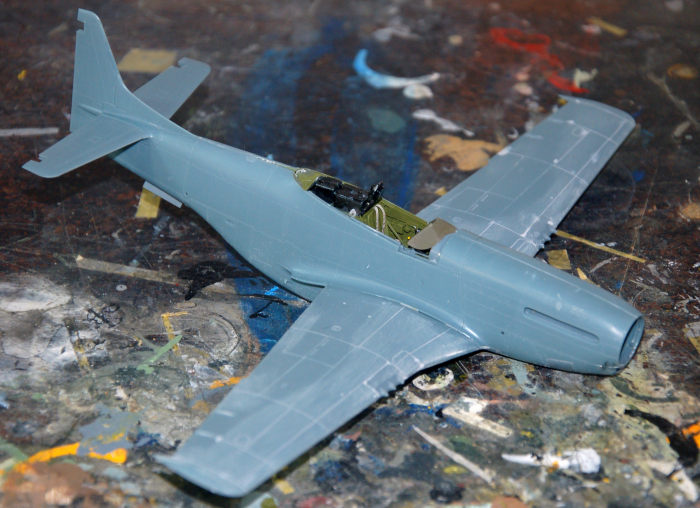 The wing
came together without difficulty.. I particularly liked the separate section for
the machine guns, which obviated having to clean up a seam through them. I
decided to take the effort to do the puttied wing. I used Mr Surfacer over the
panel lines, then sanded them down. I had to go over several of them to fully
seal the panel lines, and ended up using CA glue for this. On future builds, I
will do this with CA glue to begin with. For those who don’t want to go to this
effort, the panel lines are petite enough you can get away with just painting
the wing an “aluminum lacquer” color - I’ve seen puttied wings on restored P-51s
and you can still note panel lines from close up.
The wing
came together without difficulty.. I particularly liked the separate section for
the machine guns, which obviated having to clean up a seam through them. I
decided to take the effort to do the puttied wing. I used Mr Surfacer over the
panel lines, then sanded them down. I had to go over several of them to fully
seal the panel lines, and ended up using CA glue for this. On future builds, I
will do this with CA glue to begin with. For those who don’t want to go to this
effort, the panel lines are petite enough you can get away with just painting
the wing an “aluminum lacquer” color - I’ve seen puttied wings on restored P-51s
and you can still note panel lines from close up.
Attaching the wing and fuselage sub-assemblies presented no problems, and I finished off with attaching the horizontal stabs and the radiator exhausts. I kept the control surfaces off for the painting. Again, since this model was of a P-51D-5 that had survived into 1945, I used the metal elevators.
| COLORS & MARKINGS |
I first painted the anti-glare panel with a “Green-base OD” Tamiya mixture and masked that off, then I used Vallejo metallic paints for the rest. I first applied a thin primer coat of Tamiya Gloss Black, misted on till it fully covered the model. I then used Dull Aluminum for the aluminum lacquer over the puttied wings, spraying that when dry with a clear satin varnish, which ended up looking very close to a WW2 color photo I have that shows the puttied wing. I then masked that off and shot the rest of the model with Aluminum. I used Duraluminum for the darker panels over the engine exhaust area.
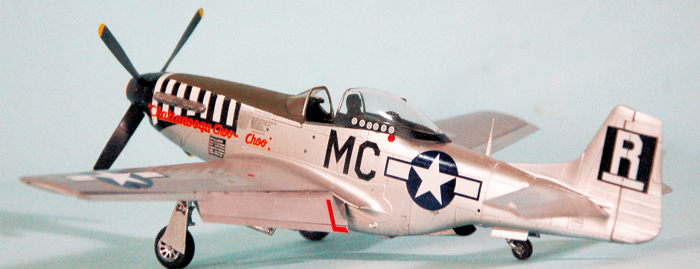 Once this
was done, I attached the control surfaces to the model.
Once this
was done, I attached the control surfaces to the model.
I used the kit decals to do “Chattanooga Choo-Choo.” They went down without any problem under a coat of Micro-Sol. There are a myriad of stencils, all of which are scale size, which means you can’t really see most of the smaller ones from further away than 5-6 inches; thus, I didn’t apply all of them, not wanting to go blind in the process.
With that done, I attached the underwing pylons. The landing gear is beautifully designed so that it only fits in the proper alignment - slightly forward, with the main axle even with the leading edge of the wing when viewed from above. Since the major mistake made with Mustang models is incorrect landing gear alignment, this care in design is definitely appreciated. I unmasked the canopy an attached it in the open position. This is the only Mustang model I have made where I did not need to make any modification to the shape of the fuselage under the very thin canopy in order to allow it to sit in the proper position. I glued the prop in position, since the mounting pin is a bit too short to reach the polycap inside.
| CONCLUSIONS |
Indeed, this is the Mustang kit this Mustang fanatic has sought for as long as I have known of the existence of the P-51 Mustang. Production design is excellent. Everything fits without problem if you have taken care in cleaning up the parts and take care with assembly, and the result will be spectacular.
 Does it
make the other kits obsolete? Far from it, though it is superior to the others
on all counts. The now 25-year old Tamiya kit definitely suffers in comparison,
with its incorrect wheel well and simplified cockpit and difficult-to-fit
canopy, but with a True Details resin cockpit and a Falcon canopy all is well.
(There’s an interesting theory going around that Tamiya might take all that
information they obtained for their 1/32 kit and scale it down to do an “update”
like they recently did for their Spitfire I - you never know.) The Airfix kit is
still very nice, and since it is half the price of this kit in the Profipack
version, if you want to use your myriad of aftermarket P-51 decals, it’s an
excellent candidate for doing markings.
Does it
make the other kits obsolete? Far from it, though it is superior to the others
on all counts. The now 25-year old Tamiya kit definitely suffers in comparison,
with its incorrect wheel well and simplified cockpit and difficult-to-fit
canopy, but with a True Details resin cockpit and a Falcon canopy all is well.
(There’s an interesting theory going around that Tamiya might take all that
information they obtained for their 1/32 kit and scale it down to do an “update”
like they recently did for their Spitfire I - you never know.) The Airfix kit is
still very nice, and since it is half the price of this kit in the Profipack
version, if you want to use your myriad of aftermarket P-51 decals, it’s an
excellent candidate for doing markings.
Bottom line: if you want a really accurate, highly-detailed P-51D model in 1/48 scale, this Eduard kit is what you want. I can see them doing different releases with different decals every six months for all the various sub-types. They definitely have a “license to print money” with this kit. Highly, highly recommended. I will definitely be building more of these.
15 August 2019
Copyright ModelingMadness.com
Review kit courtesy of Eduard.
If you would like your product reviewed fairly and fairly quickly, please contact the editor or see other details in the Note to Contributors.
Back to the Main Page Back to the Review Index Page Back to the Previews Index Page